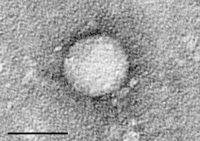
Photo from wikipedia
OBJECTIVE To describe the distribution of histopathologic diagnoses in a large population of dogs undergoing surgical treatment for spontaneous hemoperitoneum secondary to a ruptured liver mass. Additionally, to describe survival… Click to show full abstract
OBJECTIVE To describe the distribution of histopathologic diagnoses in a large population of dogs undergoing surgical treatment for spontaneous hemoperitoneum secondary to a ruptured liver mass. Additionally, to describe survival outcomes and assess for prognostic factors for overall survival time in this population. ANIMALS 200 client-owned dogs with spontaneous hemoperitoneum resulting from a liver mass. PROCEDURES Medical records from 19 veterinary referral hospitals were reviewed. Data collected included signalment, clinical signs, blood work, radiographic and ultrasonographic findings, surgical methods, intraoperative and postoperative complications, outcomes, and histopathologic findings. Follow-up information was obtained by contacting the referring veterinarian or owner. RESULTS Well-differentiated hepatocellular carcinoma, benign masses, hemangiosarcoma, and other malignant tumors accounted for 36% (72/200), 27.5% (55/200), 25.5% (51/200), and 11% (22/200) of cases, respectively. Overall survival time for all dogs was 356 days and for the above categories was 897 days, 905 days, 45 days, and 109 days, respectively. Prognostic factors for survival included diagnosis, increased ALT, anemia, and whether a transfusion was received. Overall survival time in dogs with increased ALT was 644 versus 63 days with normal values. CLINICAL RELEVANCE The majority of dogs (63.5%) were diagnosed with well-differentiated hepatocellular carcinoma or a benign process, resulting in favorable long-term survival. The distribution of histopathology for ruptured liver masses resulting in hemoperitoneum has not been previously reported and may be useful for client discussions prior to surgery.
Journal Title: Journal of the American Veterinary Medical Association
Year Published: 2022
Link to full text (if available)
Share on Social Media: Sign Up to like & get
recommendations!